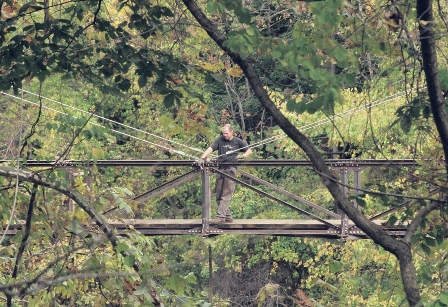|
This
Sahale Cable Stay Bridge is located on the Patapsco River at Ilchester,
MD, between Baltimore and historic Ellicott City. As bridge building legacies
go, this Sahale crew followed in some mighty large footsteps: Patterson
Viaduct Footbridge is located in what is now Patapsco Valley State Park,
on an abandoned railroad grade from the original Baltimore & Ohio Railroad
(B&O).
Reported in many
quarters as the first US railroad, construction of the first 13 miles
of track began on July 4, 1828, from Baltimore west to Ellicott's Mills
(now known as Ellicott City), opening on May 24, 1830. At Ilchester, the
railroad crossed the Patapsco River and the early engineers, modeling
their structures heavily on European influenced design, opted for stone
as the building material of choice. Culverts, retaining walls, even the
sleepers (or ties) of the early B&O were granite, and at Ilchester Engineer
Caspar Wever and Builder John McCartney constructed a stone viaduct having
two 55' primary arches and a 20' approach arch at either end. Named after
prominent B&O stockholder William Patterson this robust structure was
erected between May-December of 1829.
|
John McCartney's remarkable
achievement earned him the contract (under Caspar Wever's direction) to
later build the renowned Thomas Viaduct (also in Patapsco Valley State Park),
a 612 foot curved masonry bridge that has been in continuous service since
1835, and still carries twin parallel tracks today.
McCartney's Patterson
Viaduct stood at Ilchester until 1868, when three of the arches were wiped
out by floods of historic proportions. By that time the B&O had abandoned
stone construction as too expensive and the viaduct was replaced with
a cable stayed truss bridge of Wendel Bollman design, sitting on stone
abutments from the original viaduct. A self-educated engineer, Bollman
patented his truss design on January 6, 1852, and went on to manufacture
and construct roughly 100 such bridges (mostly for railroads) over a 20-year
period. Bollman's truss incorporates cast iron compression members with
wrought iron tension eye bar stays radiating downward and through the
truss from an apex at the top of each tower. These manufactured bridges
were an early industrial revolution success story in American railroading
but wrought iron and cast iron were soon supplanted by other, stronger,
lower maintenance bridges built of steel.
At the Patterson
Crossing, Wendel Bollman's Truss stood for roughly 40 years before it
too succumbed to flood, was replaced briefly by a temporary bridge, and
then abandoned altogether in 1903 when the railroad was realigned through
the new Ilchester Tunnel. Today, only a single representative example
of Bollman's Railroad Truss remains, in nearby Savage, MD. For over 100
years there had been no bridge at Ilchester, only the stone masonry abutments
and a single arch from the original viaduct standing in mute testimony
to a past of grand dreams, and too-oft forgotten, achievement.
Ultimately, the
indefatigable Charles Wagandt (a local entrepreneur and re-developer of
historic Oella, MD) and the Friends of Patapsco Valley & Heritage Greenway
prevailed in a 21st Century vision to see a bridge once again standing
at Ilchester. The new Patterson Viaduct Trail Bridge and companion Grist
Mill Trail Extension were dedicated on November 5, 2006, linking Ilchester
to Patapsco Valley State Park and points beyond for pedestrians and cyclists
alike. In recognition of the bridge builders in whose footsteps we followed
Sahale selected a cable stay supported truss design for the bridge, to
emulate the Bollman Truss from 1868. Additionally, the new bridge rests
on John McCartney's original foundations from the Patterson Viaduct of
1829.
|
 |
|
Bridge center through the trees.
|
 |
| Cable stay and truss hybrid construction. |
|
|